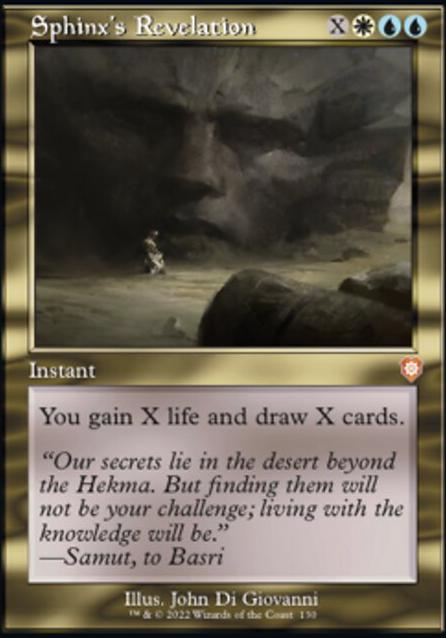Lands:
Though it seems weird to discuss lands first, in a control deck, lands are really the most important part of the deck. Suprised? Don't be. In order to keep the ball rolling with Esper, the goal is to hit land drops as consistently as possible. Cards like Celestial Colonnade, Creeping Tar Pit, Shark Typhoon, Mystic Sanctuary, and Snapcaster Mage(+Cryptic Command) want a LOT of lands in play, so that's one of our main priorities.
As with most mana-bases in Modern, our deck features fetchlands (Polluted Delta and Flooded Strand) and shocklands (Hallowed Fountain, Watery Grave, and Godless Shrine). We play only those fetchlands that fetch Islands for painless casting of Cryptic Command and Logic Knot early and fetching of Mystic Sanctuary in the late game. Mystic Sanctuary is an invaluable land, capable of producing "infinite" Cryptic Commands so long as one mode chosen is to bounce the Sanctuary back to our hand. We also play a split of shocks -- 2 Hallowed Fountains, and 2 Watery Grave, while Godless Shrine tends not to see play as a non-island that doesn't tap for blue for Cryptic Command and Archmage's Charm. After that, we have several manlands in the form of Celestial Colonnade, which serves as threats while fixing our mana, and Creeping Tar Pit, which is very adept at clocking opposing planeswalkers while ignoring our opponent's potential blockers. Field of Ruin is also present, as a way to deal with opposing manlands and other annoying lands such as Urza lands and utility lands like Desolate Lighthouse and Gavony Township.
Removal:
As you may expect, removal plays a key role in Esper. Path to Exile is a one mana answer to virtually every creature and prevents graveyard shenanigans, so it's an auto-include. Fatal Push is great for taking out early creatures while also hitting larger creatures in combination with a fetchland or a Field.
Finally, this section is rounded out by a couple of Supreme Verdicts. When the opponent floods the board with creatures to overload our spot removal, ***BOOM***. Verdict is a cheap and easy way to gain card advantage and deal with a variety of otherwise troublesome threats (ex. Lingering Souls) and strategies such as Death & Taxes, Tokens, Goblins, Zoo, Mefolk, and Humans. In fact, there are several matchups that boil down to "verdict or bust", primarily tribal decks. This is where verdict shines. When worst comes to worst, Vedict at least pitches to Force of Negation.
Counters:
As with most any blue-based control deck, Esper plays a variety of counterspells. These types of cards are important as ways to interact with non-creatures spells while still tagging creatures a large majority of the time. Cards like Blood Moon, Ensnaring Bridge, Through the Breach, and Ad Nauseam all tend to be difficult to interact with. Counterspells, while needing to be cast in the moment that the opponent is playing these cards, are a great way to deal with them when they would otherwise be hard to beat. The most iconic counterspell here is likely Cryptic Command, which is expensive, but provides great utility. It is one of the identifying cards of control in Modern, and it coincidentally also pairs very well with the newer Mystic Sanctuary. Force of Negation is also a mainstay for control, being a "free" counterspell that can be played as early as turn 1 to answer opposing Aether Vials, Neoforms, accelerated Blood Moons, etc. It also allows us the ability to 'tap out' for a threat such as a Jace, the Mind Sculptor while still being able to Force a threat during our opponent's turn. Another card that has somewhat recently come to see recognition, despite having seen long-time play in Esper, is Logic Knot. While not exactly cooperative in multiples, Knot is the closest thing to the real Counterspell that blue gets in Modern. If I could play 4 without weakening the deck, I would. Archmage's Charm is another fine card from Modern Horizons that had added great utility to Esper in its usage as a counterspell or a draw spell, with some fringe application of it's last mode coming into play as well. Finally, a few other cards tend to see play, such as Remand for early interaction and Dovin's Veto as an early and permanent answer to troublesome non-creatures that works well going late and trumps opposing countermagic. An important note is to be made here: Esper doesn't typically play cards such as Mana Leak because of their ineffectiveness in a long game.
Card Advantage:
Card Advantage is the second most important thing for control decks. When you can't play threats, how do you pull ahead? The answer is in cards. Digging deeper with draw spells helps to find you more interaction, more lands, or a wincon once you are far enough ahead. By using cards like Snapcaster Mage, Esper Charm, Archmage's Charm, etc., Esper is easily able to keep up with everything the opponent is doing while incidentally hitting land drops for an eventual planeswalker to help close the door on our opponent.
Because of these cards, Esper is quite resilient to hand disruption, such Thoughtseize and Inquisition of Kozilek, because of Esper's redundancy and ability to dig for answers, should the need arise. The ideal game for Esper is to hit every land drop, while killing/countering some stuff, and draw a bunch of cards to reach the end-game, and Esper does it well.
Finishers:
The grand finale! There are a variety of options for such "win conditions", but Teferi, Hero of Dominaria, Jace, the Mind Sculptor, Shark Typhoon, Celestial Colonnade, and Creeping Tar Pit are the most common ones. Wincons are meant to destroy your opponent with precision and/or inevitability, and there are a few options, each with their own upsides and downsides. In no particular order, here's a list of a few others I could think of:
And many more...

